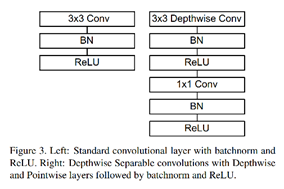MobileNets: Efficient Convolutional Neural Networks for Mobile Vision Applications
论文地址: Arxiv Paper
Github: Tensorflow, Caffe
-
Related work
构建小的、高效网络的两种方法
- 压缩训练好的模型 shrinking / factorizing / compressing
- 直接训练小模型 Flattened networks / Xception / Squeezenet
-
深度可分离卷积 Depthwise Separable Convolution
图(a)中的标准卷积 = 图(b) depthwise conv + 图(c) 1x1 pointwise conv
标准卷积的computation cost:
cost1 = ic * kh * kw * oc * oh * ow (每个输出的像素点要做ic*kh*kw次乘法)
-
优化后卷积的computation cost:
cost2 = kh * kw * oc * oh * ow + ic * oc * oh * ow (每个输出的像素点要做kh*kw次乘法)
- cost2 / cost1 = 1/ic + 1/ (kh * kw) 计算量减少 8 ~9倍
MobileNet 对大多数移动终端的CPU指令加速硬件非常友善。
SIMD (single instruction multiple data, 单指令多数据流),能够复制多个操作数,并把它们打包在大型寄存器的一组指令集

- Network structure and training
-
将原来左边的op组合改为右边的结构

-
网络有28层

-
其中conv1x1的占总参数的75%,占总计算时间的 95%

-
超参数
-
Width multiplier: thinner models
改变ic和oc,减少特征图数量,让网络变瘦
kh * kw * alpha * oc * oh * ow + alpha * ic * alpha * oc * oh * ow
-
Resolution multiplier: reduced representation
改变输出图像的分辨率
kh * kw * alpha * oc * beta * oh * beta * ow + alpha * ic * alpha * oc * beta * oh * beta * ow
-
-
Reference